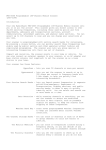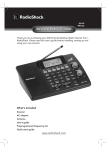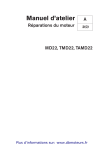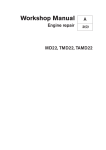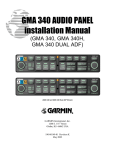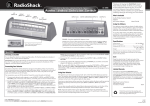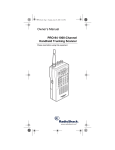Download Radio Shack 200 User`s guide
Transcript
20-135 PRO-135 Handheld Radio Scanner Thank you for purchasing your 200–channel Handheld Radio Scanner from RadioShack. What’s Included Scanner Antenna Belt Clip (2) Screws Preprogrammed Frequency List User’s Guide Quick Start Guide Please read this user’s guide before installing, setting up, and using your new scanner www.radioshack.com Contents Scanner Setup ............................................. 4 Scanner Features ....................................................4 Connecting the Antenna.........................................6 Attaching the Belt Clip............................................6 Powering Your Scanner...........................................6 Installing Batteries..............................................7 Battery Notes....................................................8 Recycle Rechargeable Batteries.......................9 Using External Power..........................................9 Connecting Headphones ..................................... 10 Listening Safely ................................................ 10 Understanding Your Scanner .............................. 10 Birdie Frequencies .......................................... 11 Turning on the Scanner........................................ 12 Programming Frequencies into Channels ........ 12 Searching .................................................. 14 Limit Search .......................................................... 14 Starting Limit Search ...................................... 14 Programming Search Ranges........................ 14 Fine Tune................................................................ 15 Service Bank Search............................................ 16 Storing Frequencies Found During a Search .... 16 Search Skip Memory.............................................17 Search Speeds ...................................................... 18 Signal Stalker I...................................................... 18 Using Signal Stalker I ...................................... 18 Setting the Signal Stalker I Options .............. 19 Signal Stalker I Options................................... 19 Scanning.................................................... 21 Scanning Stored Channels.................................. 21 2 Contents Manually Selecting a Channel ............................ 22 Weather Scan........................................................ 22 Weather Alert........................................................ 22 Testing the Weather Alarm............................. 23 Skywarn ................................................................. 23 About Skywarn ................................................. 23 Settings ..................................................... 25 Setting Delay ......................................................... 25 Turning Channel-Storage Banks On or Off........ 25 Locking Out Channels.......................................... 26 Setting Priority ...................................................... 26 Using Keylock .........................................................27 Using the Display Backlight .................................27 Setting the Auto Backlight Display.................27 Setting the Power On Backlight..................... 28 Setting the Keytone ............................................. 28 Setting the Battery Save Function ..................... 28 Advanced Programming .............................. 30 Transferring Data To or From another Scanner 30 Cloning Your Scanner ...................................... 30 Transferring Data From a PC ...............................31 Wired Programming .........................................31 Additional Information................................ 32 FCC Notice ............................................................. 32 Scanning Legally................................................... 32 Care ........................................................................ 33 Service and Repair........................................... 33 6SHFLÀFDWLRQV....................................................... 34 Troubleshooting .................................................... 36 Resetting your Scanner....................................37 3 Scanner Setup Scanner Setup Scanner Features SCAN / Scan the stored channel frequencies. Press and hold to activate Signal Stalker I. MAN Go to manual mode. SRCH Start a limit search. TUNE / MENU Operate Fine Tune. Press and hold to enter menu. MENU WX PSE SRCH MAN SCAN TUNE MAR POL AIR SVC 1 2 3 ALERT HAM PRI 4 5 6 L/O 7 8 9 DELAY PGM CL 0 • ENT KEYLOCK SVC Press to put the scanner in service mode. 1/MAR (Marine) Press after SVC to select the marine band. 2/POL (Police) Press after SVC to select the police and fire band. 3/AIR Press after SVC to select the air band. 4/HAM Select the ham band in service mode. 0-9 Input a number. 4 Scanner Setup WX / Start weather scan. Press and hold to activate Skywarn. PSE (Pause) Stop and resume search or scan. S/T Search up and down a selected frequency range; selects options in menu mode. / KEYLOCK Turns the display and key backlight on. Press and hold to lock the keypad. PRI (Priority)/ALERT Turns the priority function on or off. Press and hold to turn weather alert on and off. L/O Lockout selected channels or skip specified frequencies during a search. CL Press to clear an entry. MENU WX PSE SRCH MAN SCAN TUNE MAR POL AIR SVC 1 2 3 ALERT HAM PRI 4 5 6 L/O 7 8 9 DELAY PGM CL 0 • ENT KEYLOCK • / DELAY Enter a decimal point. Turn delay on or off. ENT (Enter) / PGM (Program) Complete the entry of frequencies. Put the scanner in programming mode. 5 Scanner Setup Headphones VOLUME/OFF Turn the scanner on or off; adjust the volume. SQUELCH Adjust the squelch. Connecting the Antenna Attach the supplied antenna to the scanner by aligning the slots around its base with the tabs on the scanner, and then slide into place. When using an external antenna, always connect with 50-ohm, RG-58, or RG-8, coaxial cable. If the antenna is over 50 feet from the scanner, use RG-8 low-loss dielectric coaxial cable. If your antenna’s cable does not have a BNC connector, your local RadioShack store carries a variety of BNC adapters. Attaching the Belt Clip Use a Phillips-head screwdriver and the supplied screws to attach the clip to the scanner. Powering Your Scanner You can power your scanner with batteries or an AC adapter. 6 Scanner Setup Installing Batteries 1. Remove the battery compartment cover. 2. Set the Battery Switch inside the battery compartment to the appropriate setting: • ALKALINE when using alkaline batteries. • Ni-MH when using rechargeable (Ni-MH) AA batteries. 3. Insert two AA batteries (not included) into the battery compartment and two AA batteries into the battery compartment cover, matching the polarity symbols (+ and -) marked inside. 4. Replace the cover. Battery Switch Warning: Only set the Battery Switch to NiMH for use with nickel metal hydride (Ni-MH) rechargeable batteries. Never use non-rechargeable batteries when the switch is set to Ni-MH. 7 Scanner Setup To charge batteries: 1. Set the Power Switch to Ni-MH. 2. Install rechargeable batteries. 3. Connect an external power source to the DC 9V 300mA jack. The scanner stops charging automatically after a maximum of 14 hours. Warning: Do not attempt to charge batteries if non-rechargeable batteries are installed in the scanner and the switch is set to Ni-MH, or if you are unsure of the switch’s position. Nonrechargeable batteries will get hot and can explode if you try to recharge them. The scanner displays Er CHArg if the wrong batteries are detected. Battery Notes • When battery power is low, flashes and the scanner beeps every 15 seconds. When battery power is depleted, the scanner turns itself off. • Rechargeable batteries last longer and deliver more power if you let them fully discharge once a month. To do this, use the flashes. scanner until • Use only fresh batteries of the required size and recommended type. Do not mix old and new batteries, different types (alkaline or rechargeable), or rechargeable batteries of different capacities. • Remove old or weak batteries. If you will not use the scanner with batteries for a month, remove the batteries. Batteries can leak chemicals that destroy electronic circuits. • Always dispose of old batteries promptly and properly. Do not bury or burn them. 8 Scanner Setup Recycle Rechargeable Batteries Placing rechargeable batteries into the trash or the municipal waste system can be harmful to the environment. RadioShack participates in an industry program to collect and recycle rechargeable batteries at the end of their useful life. You can return your rechargeable batteries to your local RadioShack store for recycling free of charge. Or call 1-800-THE-SHACK (1-800-8437422) for information on recycling rechargeable batteries in your area. RadioShack’s involvement in this program is part of the company’s commitment to preserving our environment and conserving our natural resources. Using External Power You can power your scanner using a power source that supplies 9V DC and delivers at least 300mA. Its center tip must be set to positive and its plug must fit the scanner’s DC 9V 300mA jack. You can use an “Adaptaplug C” for AC adapters. Using an adapter that does not meet these specifications could damage the scanner or the adapter. To use an external power source: 1. Connect the adapter (not supplied) to the scanner’s DC 9V jack. 2. Plug the adapter into the power source. 3. To disconnect, unplug the adapter from the power source first. 9 Scanner Setup Warning: Do not connect a charging adapter to the scanner if non-rechargeable batteries (such as alkaline batteries) are installed in the scanner and the switch is set to Ni-MH, or if you are unsure of the switch’s position. Connecting Headphones For private listening, you can plug headphones (not included) into the headphone jack on top of your scanner. This automatically disconnects the internal speaker. Note that the sound is not in stereo. Listening Safely To protect your hearing, follow these earphone or headphones guidelines: • Do not listen at extremely high volume levels. Extended high-volume listening can lead to permanent hearing loss. • Set the volume to the lowest setting before listening. Turn on the scanner, and adjust the volume to a comfortable level. • After you set the volume, do not increase it. Over time, your ears adapt to the volume level, so a volume level that does not cause discomfort might still damage your hearing. • Even though some earphones/headphones let you hear some outside sounds when listening at normal volume levels, they still can present a traffic hazard. Understanding Your Scanner We use a few simple terms in this manual to explain the features of the scanner. Familiarize yourself with these terms and the scanner’s features, and you can put the scanner to work for you right away. 10 Scanner Setup The scanner scans conventional frequencies. A frequency, expressed in kHz or MHz, is the tuning location of a station. To find active frequencies, use the search function or consult an online resource such as www.radioreference.com. Besides searching within a selected frequency range, you can also search your scanner’s service banks. Service banks are preset groups of frequencies categorized by the type of services that use those frequencies. The scanner is preprogrammed with all the frequencies allocated to the Ham, Marine, Aircraft, and Police (Fire/ Emergency) services. When you search and find a desired frequency, you can store it into a programmable memory location called a channel. Channels are grouped into channel-storage banks. Your scanner has 10 channel-storage banks (numbered 0-9) Each bank contains 20 channels (numbered 0-19). So the scanner has 200 channels total. You can scan the channel storage banks to see if there is activity on the frequencies stored there. Note: Search for frequencies to find your local frequencies, after you have programmed these frequencies into channels, you can scan the channels. Use each channel-storage bank to group frequencies. For example, the police department might use four frequencies in your town while the fire department uses an additional four. You could program the police frequencies in bank 0, and program the fire department frequencies in bank 1. Birdie Frequencies Every scanner has birdie frequencies. Birdies are signals created by the scanner’s internal circuits. These stray frequencies might interfere with broadcasts on the same or similar frequencies. If 11 Scanner Setup you program one of these frequencies, you hear only noise on that frequency. This scanner’s known birdie frequencies (in MHz) are: 449.18125 449.24375 449.30625 Turning on the Scanner 1. Turn SQUELCH fully counterclockwise. 2. Turn VOLUME/OFF clockwise until it clicks and you hear a hissing sound. 3. Turn SQUELCH clockwise until the hissing stops. Note: Make sure the scanner’s antenna is connected before you turn it on. To perform a quick check of scanner operation, press the WX key. If you are near a NOAA weather station, you should hear weather information. Programming Frequencies into Channels Before the scanner can begin to scan, you must program a frequency into at least one channel. To locate and store specific frequencies into channels for later use: 1. Press MAN. 2. Press ENT/PGM to put the scanner in programming mode. PGM appears. 3. Use the number keys to enter both the channel storage bank and the channel number you want to assign to a frequency. Example shows entering bank 1 channel 00. 4. Press MAN. 12 Scanner Setup Note: If you entered an invalid bank or channel number, Error appears and the scanner beeps. Enter a valid channel. 5. Use the number keys to enter the frequency, using • for the decimal point. 6. Press ENT/PGM to store the frequency into the channel. 7. To program the next channel in sequence, press S or T and repeat Steps 5 and 6. Notes: • If you entered an invalid frequency in Step 5, Error appears and the scanner beeps. Enter a valid frequency. • If you entered a frequency in Step 5 that already exists on another channel, the scanner beeps and displays that channel. Press CL to clear the display, or press ENT/PGM to store the frequency in both channels. • The scanner automatically rounds the entered number to the nearest valid frequency. For example, if you enter 151.473 (MHz), your scanner accepts it as 151.475. • After a transmission, the scanner automatically pauses for 2 seconds on this channel before proceeding to the next active transmission. Press •/DELAY to turn the delay function on or off. The scanner stores this setting in the channel. If you do not have a list of frequencies in your area, use a limit search, fine tune, or service search to find transmissions. A good online resource is www.radioreference.com. 13 Searching Searching Use the search function to find active frequencies. While doing a limit search, fine tune, or service bank search, press •/DELAY to turn the 2-second delay on or off. Limit Search This feature lets you search through preset frequency ranges. You can also program a range. The preset frequency ranges are 25.0000 512.0000MHz. Starting Limit Search 1. Press SRCH. SRCH and -L- appear. 2. Press T to search down or S to search up. 3. When the scanner stops on a transmission, quickly press PSE to stop searching and listen to the transmission. PAUSE appears. To step through the frequencies during search pause mode, press T or S. 4. To release the hold and continue searching, press PSE. Programming Search Ranges To define the search range during a limit search: 1. Press MAN then press ENT/PGM to put the scanner in programming mode. 2. Press SRCH to go to programming search bank mode. 14 Searching 3. Using the number keys, enter the lower limit frequency, and then press ENT/PGM. 4. Press T or S to move from lower to upper. 5. Using the number keys, enter the upper limit frequency, and then press ENT/PGM. Fine Tune You can search up or down from the currently displayed frequency using a fine tune search. Searching stops when a transmission is found and resumes after the transmission ends (searching resumes after two seconds if delay is on). 1. When the frequency you want to start from appears, press TUNE. Or, from search pause mode, enter a frequency using the number keys, then press TUNE. Note: If you enter an invalid frequency, the scanner beeps and displays Error. -t- appear. 2. SRCH, PAUSE, and 3. Press T or S to move up or down one frequency step. Or press TUNE to start the fine tune search. 4. Press T or S to change search direction. 5. Press PSE to pause the search. 15 Searching Service Bank Search The scanner is preprogrammed with all the frequencies allocated to Ham, Marine, Aircraft, and Police (Fire/Emergency) transmissions. To search the service banks, press SVC. The current service symbol appears and the scanner starts searching. To select a different service bank, press 1/MAR, 2/POL, 3/AIR, or 4/HAM. Note: Because there are many different frequencies allocated to Ham and Aircraft, it can take several minutes to search all the service frequencies. Storing Frequencies Found During a Search To store frequencies you find in limit search, fine tune, service bank, or Signal Stalker I searches: 1. Press PSE at the frequency you want to store. 2. Press ENT/PGM to enter programming mode. 3. The screen flashes, alternating between the smallest empty channel number, 000.000, and the frequency you want to store. Note: If there are no empty channels, the scanner selects the first channel in the bank. 4. Enter the bank number where you want to store the frequency. 5. Press T or S to change the channel. 6. Press ENT/PGM to store the frequency or CL to cancel. 16 Searching Note: If the same frequency already exists on another channel, the scanner beeps and displays that channel. Press CL to cancel, or press ENT/PGM to store the frequency in both channels. Search Skip Memory You can skip up to 50 unwanted frequencies during a limit search, fine tune, service bank, or Signal Stalker I search. Note: You cannot skip frequencies during WX service search. To skip a frequency, press L/O when the scanner stops on the frequency during a search. The scanner stores the locked-out frequency in memory and automatically resumes the search. To clear a single frequency from skip memory: 1. Press PSE to stop the search. 2. Press T or S to select the frequency. L/O appears. 3. Press L/O. L/O disappears. To clear all skipped frequencies at once: 1. While searching, press PSE. 2. Hold down L/O until the scanner beeps twice. Notes: • If you selected all frequencies to be skipped within the search range, the scanner beeps 3 times and does not search. • If you select more than 50 frequencies to skip, each new frequency replaces a frequency previously stored, beginning with the first stored frequency. • Press T or S to select a skipped frequency during pause. L/O appears when you select a skipped frequency. 17 Searching Search Speeds The scanner has two search speeds: Normal search at 55 steps/second and Hypersearch at 160 steps/second. Hypersearch applies only to the 5 kHz step bands (25–27.995 MHz, 28–54 MHz, and 137–174 MHz). Signal Stalker I Signal Stalker I detects and then displays the frequency of nearby strong radio transmissions. Signal Stalker I works well for locating mobile and handheld two way radios in areas with no other strong transmission sources. Signal Stalker I might not correctly display frequency information for transmitters using a highly directive antenna (such as an amateur radio beam antenna), if there are many transmitters operating at the same time in the same area, or if the transmitter is a broadcast television station. Using Signal Stalker I To turn on Signal Stalker I, turn SQUELCH fully clockwise, then press and hold SCAN/ . The icon appears. (In Only mode, the icon flashes.) Every 2 seconds, the scanner searches for active frequencies in the range you specify in “Setting the Signal Stalker I Options.” When the scanner finds a frequency, it alerts you according to its settings and “Found” appears. Press any key to confirm the displayed frequency. Press T or S to resume scanning. To turn off Signal Stalker I and turn on normal icon scanning, press and hold SCAN/ . The disappears. Note: Signal Stalker I doesn’t run in weather search or programming mode. 18 Searching Setting the Signal Stalker I Options 1. Press and hold TUNE/MENU to open the menu. 2. Press T or S to select a Signal Stalker I menu icon appears with Signal option. (The Stalker I menu options.) Note: See below for a description of the Signal Stalker I options. 3. Press ENT/PGM. The scanner flashes the setting On or OF (On or Off). 4. Press T or S to select On or OF. Press ENT/ PGM. 5. Press T or S to select another option or press CL to exit the menu mode. Signal Stalker I Options • ALErt: Alert. Set to On if you want to hear an alert when Signal Stalker I finds a frequency. • Light: Backlight. Set to On if you want the backlight to flash when Signal Stalker I finds a frequency. • PGrSCr: Pager Screen. Set to On if you want to screen out common pager frequencies. • Only: Only Mode. Set to On to turn off normal scanning while Signal Stalker I runs. Set to Off to continue normal scanning while Signal Stalker I runs in the background. • Lo bnd: Low Band. Set to On to search VHF Low Band (25-54MHz). • Airbnd: AIR Band. Set to On to search AIR Band (108-137MHz). • Hi bnd: High Band. Set to On to search VHF High Band (137-174MHz). 19 Searching • UHFbnd: UHF Band. Set to On to search UHF Band (380-512MHz). • IntrPt: Voice Interrupt. While Signal Stalker I is on and the scanner is receiving an audio signal (voice) in normal scanning, the scanner checks the Signal Stalker I every 2 seconds causing the audio signal to break at that moment. Set Voice Interrupt to On if you want to keep the Signal Stalker I active despite interruptions while the scanner is receiving an audio signal. Set to Off if you do not want to hear interruptions. The scanner resumes checking signals when the audio signal ends. 20 Scanning Scanning Scanning Stored Channels Press SCAN to begin scanning your programmed frequencies. SCAN appears and the scanner scans through all non-locked channels in the activated banks. Select any combination of banks to scan by pressing the corresponding number keys. The bank numbers appear at the top of the display. The bank number which is currently being scanned blinks. When the scanner finds a transmission, it stops on it. When the transmission ends, the scanner resumes scanning. If it is a long transmission and you want to move on, press SCAN to resume scanning. If you press PSE when the scanner stops on a transmission, the scanner goes to manual mode. Press PSE or SCAN to resume scanning. Notes: • If you have not stored any frequencies into channels, the scanner does not scan. • If the scanner picks up unwanted partial, or weak transmissions, turn SQUELCH clockwise to decrease the scanner’s sensitivity to these signals. • To listen to a weak or distant station, turn SQUELCH counterclockwise. • To ensure proper scanning, adjust SQUELCH until the audio mutes. 21 Scanning Manually Selecting a Channel You can continuously monitor a single channel without scanning. This is useful if you want to monitor a specific channel or if you hear an emergency broadcast on a channel and do not want to miss any details, even though there might be periods of silence. To directly access a channel: 1. Press MAN to stop scanning. 2. Enter the bank and channel number and press MAN. The selected channel appears. To stop at a channel while scanning: 1. Press MAN to stop scanning. 2. Press T or S to select the next or previous channel. 3. Press SCAN to resume scanning. Weather Scan To scan for weather transmissions: 1. Press WX/ . WX appears. Change the search direction by using T or S. 2. To stop the search, press PSE. PAUSE appears. Weather Alert 1. Press WX/ to start the weather scan. 2. Press PRI/ALERT. ALT appears. If the scanner detects the 1050Hz weather alert signal, it sounds an alarm for 5 minutes and ALT blinks. After the 5-minute alarm, the scanner beeps every 10 seconds. Press any key to turn off the alert. The audio turns on so you can hear the weather broadcast. 22 Scanning Testing the Weather Alarm To hear the alarm for the weather alert signal, press WX/ to select the weather service, then hold down PRI/ALERT for about two seconds. The tones sound and TEST appears. Press any key to end the test. Skywarn The Skywarn function lets you jump directly to the last channel in memory (Bank 9, Channel 19) from any mode by pressing and holding WX/ . The scanner goes into manual mode and starts receiving transmissions in the last channel. Note: Before using this feature, enter the local Skywarn frequency for your area into Bank 9, Channel 19. The scanner has 10 channels for Skywarn: Bank 9, Channels 10-19. Press T or S to select other Skywarn channels. Press MAN to exit Skywarn. Note: If no frequencies are programmed in the Skywarn channels, No Prg appears and the scanner sounds an error tone. About Skywarn Skywarn is an organized group of trained weather observers. A Skywarn group exists in virtually every US County with a significant population. During inclement weather, reports made by Skywarn observers include information about: • Pea-sized and larger hail • Wind and wind gusts of 40 MPH and greater • Heavy rainfall • Lightning (cloud-to-cloud and especially cloud-to-ground) • Wall clouds seen in severe thunderstorms 23 Scanning (which spawn tornadoes) • Severe lowering of a wall cloud • Turbulence in a wall cloud • Funnel clouds • Tornadoes • High water areas • Downed power lines • Other emergency conditions that affect life or property Listen to NOAA for weather alerts and warnings, watch box notices, and weather-forecasts. Listen to Skywarn to hear trained observers in your vicinity call in official reports to a net control station which relays those reports to NOAA and other emergency agencies. Note: If you tune to a Skywarn frequency when the Skywarn net is not active, you may hear nothing, or you may hear amateur radio operators talking on a local repeater system. 24 Settings Settings Setting Delay Sometimes a user might pause before replying to a transmission. To avoid missing a reply on a specific channel, the scanner automatically programs a 2-second delay into any channel or frequency. Depending on the scanner operation, follow one of these steps to turn the delay on or off. • To turn off the 2-second delay, press •/DELAY while the scanner is monitoring a channel, scanning, or searching. DLY disappears. • To turn on the 2-second delay for a single channel, manually select the channel and press •/DELAY. DLY appears. • To turn on the 2-second delay for the search function, press •/DELAY while the scanner is searching. DLY appears and the scanner automatically adds a 2-second delay to every frequency it stops on in that band. The Signal Stalker I delay time is 10 seconds. Turning Channel-Storage Banks On or Off You can turn each channel-storage bank on and off. When you turn off a bank, the scanner does not scan any of the 20 channels in that bank. While scanning, press the number key that corresponds to the bank you want to turn on or off. The scanner scans all the channels within the displayed banks that are not locked out. Notes: • You can manually select any channel within a bank, even if that bank is turned off. 25 Settings • One bank must always be active. If you try to turn off all banks, bank 0 remains. Locking Out Channels You can increase the scanning speed by locking out channels that have a continuous transmission (such as a weather channel). To lock out a channel, quickly press L/O when the scanner stops on a transmission. Or, manually select the channel and then press L/O. L/O appears. Note: You can still manually select locked-out channels. To remove the lockout from a channel, manually select the channel, then press L/O. L/O disappears. To unlock all channels in the selected banks, press MAN to stop scanning, then hold down L/O until the scanner beeps twice. Setting Priority The priority feature lets you scan through the channels and still not miss important or interesting calls on specific channels. You can program one stored channel in each bank as a priority channel. The scanner checks the designated priority channel every two seconds in each bank. Press PRI during scanning to turn the priority feature on and off. PRI appears when priority is on. Note: If you have locked out all priority channels, All Loc appears when you activate the priority feature. The scanner automatically designates each bank’s 26 Settings first channel as its priority channel. To select a different channel as the priority channel: 1. Press MAN then press ENT/PGM. 2. Press T or S to select the channel you want to set as priority, then press and hold PRI. Or, enter the bank and channel number you want to set as priority and then press PRI. P appears to the left of the selected channel frequency. 3. Repeat Steps 1 and 2 for the channel in each bank that you want to program as a priority channel. Using Keylock The keylock feature protects the scanner from accidental program changes. When the scanner is locked, the only control that operates is / KEYLOCK. 1. To turn on keylock, hold down appears. until /KEYLOCK 2. To turn off keylock, hold down disappears. until /KEYLOCK Using the Display Backlight To turn on the display light for easy viewing at night, press .The display lights for 15 seconds. Setting the Auto Backlight Display You can set the scanner so the backlight turns on for about 5 seconds when the scanner receives signals. If you press a key within the 5 seconds, the display remains lighted for 15 more seconds. To turn auto backlight display on or off: 1. Press and hold TUNE/MENU to open the menu. 27 Settings 2. Press T or S to select AutLit, then press ENT/PGM. 3. Press T or S to select On or OF. Press ENT/ PGM. 4. Press TUNE/MENU or CL to exit the menu mode. Setting the Power On Backlight The backlight can be set to light for 5 seconds when you power on the scanner. To turn the power on backlight on or off: 1. Press and hold TUNE/MENU to open the menu. 2. Press T or S to select PonLit, then press ENT/PGM. 3. Press T or S to select On or OF. Press ENT/ PGM. 4. Press TUNE/MENU or CL to exit the menu mode. Setting the Keytone Each time you press any of the scanner’s keys, the scanner sounds a tone. To turn the scanner’s key tone on or off: 1. Press and hold TUNE/MENU to open the menu. 2. Press T or S to select bEEP, then press ENT/PGM. 3. Press T or S to select On or OF. Press ENT/ PGM. 4. Press TUNE/MENU or CL to exit the menu mode. 28 Settings Setting the Battery Save Function The battery save feature conserves energy when the scanner is set to monitor a manually selected channel and it is not actively scanning. The scanner repeatedly turns off the internal power for one second, and then turns it back on for half a second to check for a transmission. To turn the battery save function on or off: 1. Press and hold TUNE/MENU to open the menu. 2. Press T or S to select b-SAVE, then press ENT/PGM. 3. Press T or S to select On or OF. Press ENT/ PGM. 4. Press TUNE/MENU or CL to exit the menu mode. 29 Advanced Programming Advanced Programming Transferring Data To or From another Scanner You can clone your scanner by transferring the programmed data to or from another PRO-135 scanner using a connecting cable. You can also upload or download programmed data from a PC through wired programming. Cloning Your Scanner You can clone all the frequencies in your PRO-135 to another PRO135 or PRO-136 using an optional interface cable with 1/8-inch phone plugs on both ends and software available at your local RadioShack or www.radioshack.com. 1. Make sure the scanners are turned off and then plug the cable into each scanner’s PC/IF jack. 2. Turn on both scanners. WirEd and PGM appear. 3. Press T or S on the scanner from which you want to send frequencies. This is the “master unit.” The receiving scanner is the “slave unit.” 4. Press ENT/PGM on the master unit to send the data. SEnd and the transfer progress are displayed in the master unit. 30 Advanced Programming 5. When the data transfer is completed, donE appears on both units. If the transfer was not successful, Error appears. 6. After the clone operation is complete, remove the cable, turn both units off and then on again. Transferring Data From a PC Wired Programming You can transfer programming data to your scanner using your PC and an optional interface cable and software (available at your local RadioShack or www.radioshack.com). 1. Make sure your scanner is turned off. 2. Connect the interface cable to your computer and then connect the other end of the cable to the scanner’s PC/IF jack. 3. Install the software to your computer and run the program. 4. To set up the program, click on Tools, select Configuration, and select PRO-135 (if necessary). 5. Turn the scanner on. The scanner automatically goes into the wired programming mode. WirEd and PGM appear. When the scanner begins to communicate with the PC, PC flashes. 6. PC stops flashing when the scanner has successfully received all data. Turn the scanner off and remove the cable. 7. Turn the scanner on again. 31 Additional Information Additional Information FCC Notice Your scanner might cause radio or TV interference even when it is operating properly. To determine whether your scanner is causing the interference, turn off your scanner. If the interference goes away, your scanner is causing it. Try the following methods to eliminate the interference: • Move your scanner away from the receiver. • Connect your scanner to an outlet that is on a different electrical circuit from the receiver. • Contact your local RadioShack store for help. In some areas, mobile use of a scanner is unlawful or requires a permit. Check the laws in your area. This device complies with Part 15 of the FCC Rules. Operation is subject ot the following two conditions: (1) This device may not cause harmful interference. (2) This device must accept any interference received, including interference that may cause undesired operation. Scanning Legally Your scanner covers frequencies used by many different groups including police and fire departments, ambulance services, government agencies, private companies, amateur radio services, military operations, pager services, and wireline (telephone and telegraph) service providers. It is legal to listen to almost every transmission your scanner can receive. However, there are some transmissions you should never intentionally listen to. These include: • Telephone conversations (cellular, cordless, or other private means of telephone signal transmission) • Pager transmissions • Any scrambled or encrypted transmissions 32 Additional Information According to the Electronic Communications Privacy Act (ECPA), as amended, you are subject to fines and possible imprisonment for intentionally listening to, using, or divulging the contents of such a transmission unless you have the consent of a party to the communication (unless such activity is otherwise illegal). This scanner is designed to prevent reception of illegal transmissions, in compliance with the law which requires that scanners be manufactured in such a way as to not be easily modifiable to pick up those transmissions. Do not open your scanner’s case to make any modifications that could allow it to pick up transmissions that are not legal to listen to. Doing so could subject you to legal penalties. We encourage responsible, legal scanner use. Care Keep the scanner dry. If it gets wet, wipe it dry immediately. Use and store the scanner only in normal temperature environments. Handle the scanner carefully; do not drop it. Keep the scanner away from dust and dirt, and wipe it with a damp cloth occasionally to keep it looking new. Service and Repair If your scanner is not performing as it should, take it to your local RadioShack store for assistance. To locate your nearest RadioShack, use the store locator feature on RadioShack’s website (www. radioshack.com), or call 1-800-The Shack (800-8437422) and follow the menu options. Modifying or tampering with the scanner’s internal components can cause a malfunction and might invalidate its warranty and void your FCC authorization to operate it. 33 Additional Information Specifications Frequency Coverage 25.0000-27.9950 (in 5 kHz steps) 28.0000-54.0000 (in 5 kHz steps) 108.0000-136.9875 (in 12.5 kHz steps) 137.0000-174.0000 (in 5 kHz steps) 380.0000-399.9875 (in 12.5 kHz steps) 400.0000-512.0000 (in 6.25 kHz steps) Sensitivity (AM/FM) FM ........................... 20 dB S/N at 3 kHz deviation 28.0000-54.0000............................................ 0.4µV 137.0000-174.0000........................................ 0.5µV 400.0000-512.0000........................................ 0.5µV AM ......................... 20 dB S/N at 60% modulation 25.0000-27.9950............................................ 1.3µV 108.0000-136.9875........................................ 1.5µV 320.0000-399.9875........................................ 1.3µV IF Rejection at 453.2500 MHz .......................60 dB IF Frequencies 254.30-40 MHz, 10.85 MHz, 450 kHz Channels.............................................................200 Number of Banks................................................ 10 Operating Temperature Normal ...................... .-4° to 140°F (-20° to 60°C) Signal Stalker I........... 14° to 140°F (-10° to 60°C) Scan Speed......................... 55 Channels/Second Search Speed Normal .......................................55 Steps/Second Hypersearch.............................160 Steps/Second 34 Additional Information Antenna Impedance.........................................50ȍ Audio Output........................... 260 mW maximum Built-in Speaker................ 1.25 Inches (32 mm) 8 ...................................................... Dynamic Type Power 4 AA Alkaline Batteries (6.0 VDC), or 4 AA Rechargeable Ni-MH Batteries (4.8 VDC) or Optional AC Adapter (9V DC; 300mA; center tip set to positive) Current Drain Squelched....................................................75 mA Full Output ................................................160 mA Dimensions (HxWxD)....................6 x 2.6 x 1.75 in ................................................... (153 x 66 x 44 mm) Weight (without antenna, batteries, or belt clip) ............................................................ 8.4 oz (240 g) Specifications are typical; individual units might vary. Specifications and depictions are subject to change and improvement without notice. 35 Additional Information Troubleshooting Problem Cause Solution Scanner is on but SQUELCH is not Adjust SQUELCH. will not scan. adjusted correctly. Only one channel Store frequencies into or no channels are more than one chanstored. nel. Scanner won’t work at all. Scanner is not receiving power. Recharge the rechargeable batteries or replace the non-rechargeable batteries. The AC adapter or Be sure the adapter’s DC adapter is not barrel plug is fully connected. plugged into the DC 9V 300 mA jack. Keypad doesn’t work. is flash- The keylock function is activated. Press and hold /KEYLOCK until disappears. Batteries are low. Recharge the rechargeable batteries or replace the alkaline batteries. ing. Poor or no reception. Error appears. Batteries are weak Check the batteries or completely dis- or make sure the AC charged. adapter or DC adapter is connected properly. Antenna loose. Make sure an antenna is connected to the scanner. Programming error. Re-enter the frequency correctly, including the decimal point. 36 Additional Information Resetting your Scanner If the scanner’s display locks up or stops operating properly, you might need to reset the scanner. Caution: This procedure clears all the information you have stored in the scanner. Before you reset the scanner, try turning it off and on again to see if it begins working properly. Reset the scanner only when you are sure it is not working properly. 1. Turn off the scanner. 2. While holding down 2, 9 and PSE, turn on the scanner. CLEAr appears for about 2 seconds as the scanner clears its memory. Note: Do not turn off the scanner again until CLEAr disappears. Otherwise, the scanner might not clear its memory properly. Follow these steps to restore the 150 preprogrammed frequencies stored in the private bank. 1. Make sure your scanner is turned off. 2. Press 3 and ENT/PGM simultaneously while turning on the scanner. After several seconds, the scanner restores the frequencies. 37 Additional Information Notes: 38 Additional Information Notes: 39 Limited One-year Warranty This product is warranted by RadioShack against manufacturing defects in material and workmanship under normal use for one (1) year from the date of purchase from RadioShack company-owned stores and authorized RadioShack franchisees and dealers. For complete warranty details and exclusions, check with your local RadioShack store. RadioShack Customer Relations 300 RadioShack Circle, Fort Worth, TX 76102 Hypersearch and Adaptaplug are trademarks used by RadioShack Corporation. 04/04 20-135 Printed in China UBZZ01353ZZ(0) 12A07 ©2007. RadioShack Corporation. All rights reserved. RadioShack and RadioShack.com are trademarks used by RadioShack Corporation.








































